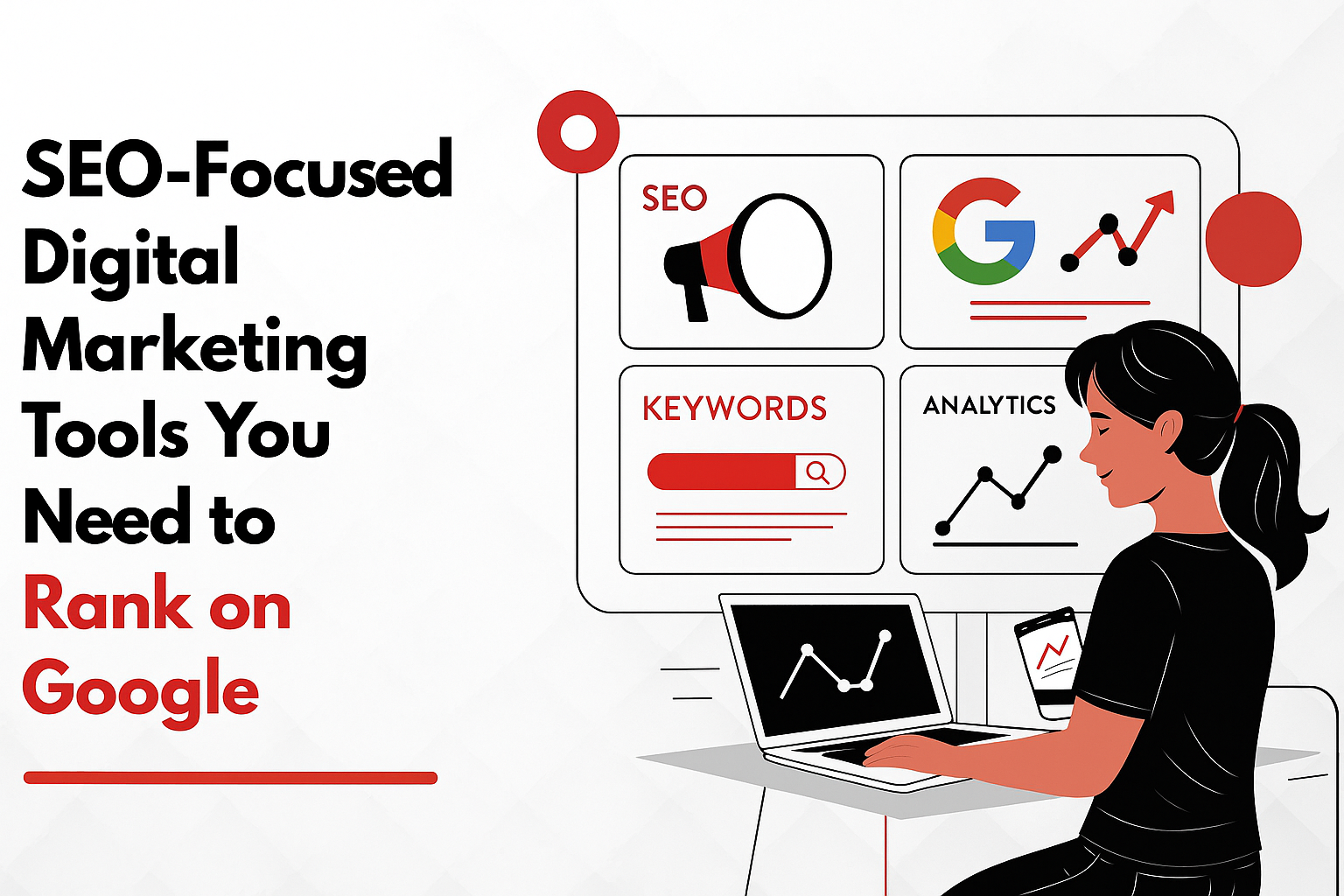Why Ranking High on Google Still Matters More Than Ever
In a world increasingly dictated by algorithms, one thing hasn’t changed visibility is everything. Google remains the first place people turn to when searching for answers, services, and solutions. Whether someone’s hunting for a local bakery or researching enterprise software, their journey often begins with a single search bar. And showing up at the top? That can make the difference between a business that’s barely hanging on and one that’s scaling confidently every quarter.
According to a 2024 report by BrightEdge, organic search drives 53% of all trackable website traffic. That number is not just impressive, it’s a loud reminder that SEO isn’t optional. It’s foundational. While social media traffic can fluctuate with algorithm changes and paid ads require constant investment, a strong SEO presence builds long-term equity. Think of it like compound interest. You invest now, and over time, your content continues to deliver value without requiring additional budget.
But SEO isn’t magic. It doesn’t happen because you stuff your content with keywords or publish a few blogs. Real SEO requires a toolkit that gives you clarity, control, and competitive insight. That’s where digital tools come into play, and not just the usual suspects everyone already knows about.
In this blog, we’re diving deep into SEO-focused digital marketing tools that aren’t just popular, but powerful. The ones that help you with keyword research, competitor tracking, technical audits, content optimization, link building, and performance tracking. And we’re doing it with depth. Each tool we cover will come with a comprehensive section, approximately 700 words in length, providing context, usage tips, real-world scenarios, and the kind of perspective a startup founder or solo marketer needs when managing time and resources.
This isn’t about pushing the most expensive tools or rehashing generic advice. It’s about spotlighting tools that help you rank based on data, user experiences, and real-world applications. Whether you're running a bootstrapped blog, building an eCommerce brand from scratch, or managing SEO for clients as a freelancer, the right tools can change your trajectory.
So let’s start with the first one and see what’s working for those aiming to climb Google's rankings.
Unlocking the Power of Semrush for Strategic SEO Growth
There’s a reason Semrush consistently ranks among the most trusted names in the SEO world. But what makes it more than just another all-in-one platform is how it helps marketers bridge the gap between scattered insight and strategic execution. Semrush isn’t just a data dashboard. It’s a decision-making engine. And when you’re trying to climb Google’s ranks in 2025, that matters more than ever.
Search behavior is shifting fast. According to Google’s latest Search Central insights from Q1 2025, more than 45% of users now engage with search results in zero-click ways through featured snippets, People Also Ask sections, and map packs. That means visibility alone isn’t enough. You have to understand how users interact with search content and position yourself where clicks still happen. Semrush equips you to do exactly that, not just through keyword research, but by helping you read the competitive landscape like a strategist.
Take, for example, a small SaaS startup launching a new product in a crowded niche. Without Semrush, they might build content around the wrong keywords or copy their competitors’ blog structure blindly. With Semrush, that same startup can analyze which keywords are converting, reverse-engineer the backlink profiles of top competitors, and map out content clusters that fill real gaps. It turns guesswork into grounded strategy.
One of Semrush’s strongest features is the Keyword Magic Tool. It doesn’t just show search volume. It surfaces related queries, trends, and intent-based groupings that help marketers think beyond primary terms. You don’t just find keywords, you discover problems people want solved. And that shift in mindset leads to better content, more qualified traffic, and longer on-page engagement.
The Site Audit feature is another essential. Technical SEO is often where startups fumble. Broken links, slow-loading pages, and mobile usability errors these things can silently kill your rankings. Semrush doesn’t just detect them. It prioritizes them based on impact, giving you a clear fix-first roadmap. In a world where Core Web Vitals now play a measurable role in search ranking, that kind of guidance is invaluable.
But what sets Semrush apart in 2025 is its evolving AI integration. As content marketers shift toward more programmatic SEO and generative workflows, Semrush now offers AI writing assistants and content templates based on top-performing competitors. That doesn’t mean it writes your content for you. But it helps you structure it with precision, avoid fluff, and match the formatting that’s already winning in the SERPs.
This blend of AI and data gives marketers a creative edge without sacrificing authenticity. Especially in markets like India or Southeast Asia, where search behavior varies widely between urban and regional users, having localized keyword data and traffic projections can be the difference between a post that gets buried and one that ranks first for months.
What’s also worth mentioning is the platform’s user-friendly design. While Semrush has depth for advanced users, its clean interface and guided wizards make it approachable for freelancers and small business owners who are just learning the ropes. Many marketing teams use it as a collaborative dashboard, aligning SEO, paid ads, and content efforts in one shared space. It becomes less of a tool and more of a command center.
For marketers who care about ROI, Semrush doesn’t just show you the metrics it reveals the story behind the movement. Why did the ranking drop? Was it a competitor update? A technical issue? A content mismatch? Semrush gives you those answers and arms you with a plan to respond. That’s how SEO becomes proactive instead of reactive.
While the platform isn’t free, the value is undeniable. For businesses serious about organic traffic, the cost is often justified by a single piece of content that lands and stays on the first page. And for those just getting started, their free plan and trial access offer enough tools to build an SEO foundation without upfront investment.
In 2025, search success belongs to marketers who blend intuition with insight. Semrush doesn’t replace your gut. It sharpens it. By showing you what’s working, where the gaps are, and how to get there faster, it becomes less of a subscription and more of a strategic partner.
Ahrefs and the Science of Outranking Your Competitors
Ahrefs has become more than just a backlink checker. In 2025, it is one of the most comprehensive SEO ecosystems for businesses that want to move from reactive to proactive optimization. It’s trusted by large agencies and solopreneurs alike because it gives clarity where most tools only offer numbers. What Ahrefs does best is expose the full playing field, not just where you are, but where your competitors are, how they got there, and how you can close the gap strategically.
To understand Ahrefs’ impact, it helps to start with how SEO has evolved. Ten years ago, it was common to focus heavily on keyword targeting and content output. The idea was simple. Publish enough, use the right terms, and traffic would follow. But as search engines have become more sophisticated, so has the competition. Google’s algorithms now consider intent, topical authority, and backlink quality in far more complex ways. And that’s exactly where Ahrefs shines.
The platform's Site Explorer tool is a deep dive into your competitor’s organic traffic, ranking keywords, top-performing pages, and backlink sources. It doesn’t just tell you what they’re doing. It shows you what’s working, what’s been declining, and where they’re vulnerable. If you’re running a direct-to-consumer skincare brand, for example, you can identify which blogs are driving the most backlinks to your competitors and pitch those same domains with better content or updated research. That level of reverse engineering gives you leverage before you even publish.
Ahrefs also changed the game with its Content Gap tool. Instead of brainstorming in isolation, you get to see which keywords your competitors rank for that you don’t. This insight is gold for newer businesses trying to compete with established domains. It’s not just about chasing volume. It’s about identifying neglected but high-converting terms that others overlooked. You build topical authority not by guessing, but by intelligently filling strategic holes.
But where Ahrefs continues to set itself apart is its link intelligence. The platform crawls the web more aggressively than nearly any other SEO tool, meaning its backlink index is one of the freshest and most reliable in the industry. With features like Link Intersect, you can spot domains that link to your competitors but not you, opening real partnership opportunities. Backlink building isn’t just outreach. It’s matchmaking between content value and domain trust. Ahrefs shows you where to begin.
The tool’s technical audit capabilities are also worth attention. While not as broad as Semrush in on-site SEO reporting, Ahrefs provides clean, actionable insights into crawl errors, duplicate content, internal linking, and performance blockers. It’s ideal for teams that need fast diagnostics without spending hours interpreting graphs.
In the context of India’s fast-growing online startup ecosystem, Ahrefs is increasingly being used by regional eCommerce players and D2C brands who want to punch above their weight in competitive categories. A recent NASSCOM study reported that over 80 percent of traffic to Indian B2C websites now comes from mobile search. That means ranking is no longer about desktop optimization or classic keyword stuffing. It’s about understanding search flow across devices, content clusters, and off-page credibility. Ahrefs gives Indian businesses the map and the tools to execute.
While Ahrefs is priced at a premium, many marketers justify the cost by treating it as a research lab rather than just an analytics platform. For teams working across SEO, content marketing, and digital PR, it replaces the need for multiple separate subscriptions. And with their Lite plan offering enough features to drive major improvements, even solo founders or early-stage startups can extract significant value.
What makes Ahrefs indispensable in 2025 is not just what it tracks, but how it teaches. Their academy and blog remain among the most comprehensive educational resources on SEO. For business owners who want more than just reports, who want to understand why rankings rise or fall, Ahrefs is both a tool and a mentor.
Semrush as a Central Brain for Multi-Channel SEO Strategy
If Ahrefs is the tactical lens through which you spy on your competition, Semrush is the strategic dashboard that helps you plan your entire campaign from the ground up. It is often viewed as an all-in-one marketing suite, but when it comes to SEO, Semrush has evolved into something far more dynamic. In 2025, it’s not just a tool you log into for data. It becomes part of your daily operating system if ranking high and staying there is part of your growth roadmap.
The first thing you notice when working inside Semrush is how integrated everything feels. It’s not just about keyword research or backlink audits. It’s about connecting those pieces to a wider digital picture. Let’s say you’re running a SaaS company in India targeting SME clients. You want to improve your organic traffic, sure. But you also want to understand how your content is performing socially, how your competitors are ranking in paid search, and whether there’s a trend you’ve missed that could help you leapfrog them. Semrush offers a single source of insight across all of that.
Its Keyword Magic Tool is one of the most comprehensive in the market. With over 25 billion keywords in its database, it doesn’t just provide ideas. It gives clusters of related terms, intent-based groupings, and live difficulty scores that adapt to algorithm updates. This allows content teams to avoid writing in a vacuum. You’re not just picking a term to chase rankings. You’re selecting entry points into larger conversations already happening in your space. You get to build content that fits a real path users are following.
One of the most underrated features is the Position Tracking tool. It allows you to monitor how your website performs on a hyper-local level. If you’re a regional business in Bengaluru or Pune, that matters more than ever. Google personalizes results based on geography, and Semrush lets you adjust strategy accordingly. You can also monitor how algorithm updates impact your rankings over time and segment your insights based on device usage. That’s powerful for brands that want to stay agile without constantly shifting direction.
Where Semrush truly sets itself apart in 2025 is in its content marketing suite. It integrates SEO with editorial planning. You can build content calendars based on keyword opportunities, track how published blogs are ranking, and even get real-time SEO optimization suggestions while writing. This means marketing teams don’t just produce more. They produce smarter. They’re not left wondering why a high-effort blog isn’t ranking. The data guides the creation from the start.
Another standout aspect is competitor intelligence. Semrush offers a wide-angle view of what other companies in your niche are doing. You can track their top pages, analyze their paid ad copy, and study their backlink growth month by month. For example, if a fintech startup sees a competitor launching a successful content hub, Semrush will break down what keywords they’re targeting, who’s linking to their new content, and where the traffic is coming from. That allows you to respond in days, not months.
India’s digital market is particularly hungry for scalable tools like Semrush. A study from Google and Bain in late 2024 showed that digital-first SMEs are growing revenue at 1.5 times the rate of traditional businesses. But that growth only comes when they act fast on the right data. Semrush fits this need by delivering clarity without complexity. Whether it’s optimizing for voice search, adapting to core updates, or building topic authority, Semrush is designed to help you do it faster and with greater precision.
The tool also plays well with others. Its integration with Google Analytics, Google Search Console, and popular CMS platforms makes it easy to sync your SEO efforts with your existing tech stack. For larger teams using project management platforms, Semrush’s task assignment and campaign tracking tools create a real workflow, not just isolated reports that sit untouched.
Cost-wise, Semrush is positioned as a mid-to-high investment tool. But its value grows the more you use it. For agencies managing multiple clients, it replaces several smaller tools. For startups focused on SEO-led growth, it reduces the trial-and-error phase by offering real-time correction. And for founders trying to wear multiple hats, it saves hours of scattered research with a centralized command center.
As algorithms evolve and the search landscape becomes more fragmented across devices and platforms, Semrush gives marketers something rare a unified view. It doesn’t just help you keep up. It helps you get ahead with purpose.
Surfer SEO as the Bridge Between Data and Content Creation
One of the biggest myths in digital marketing is that great content alone is enough to rank. While quality is always key, ranking on Google today also requires structure, optimization, and alignment with what the algorithm considers relevant. That’s where Surfer SEO becomes a vital part of any serious marketer’s toolkit. It’s not about replacing creativity with automation. It’s about enhancing your intuition with data-backed direction at every stage of content production.
Surfer SEO has gained momentum over the past few years for a good reason. It focuses on what many other SEO tools only hint at the on-page signals that tell Google your content deserves to be seen. From keyword density to structural layout, from NLP terms to internal linking strategies, Surfer doesn’t leave anything to chance. It operates like an SEO coach sitting beside your content writer, offering live feedback as they build each sentence.
Let’s take a real-world example. Imagine a startup in India offering online language learning courses. The founders want to write blog posts targeting phrases like “learn spoken English online” or “best English course for beginners.” Using Surfer SEO’s Content Editor, they can paste in their draft and immediately get a score that reflects how aligned their article is with the top-ranking pages on that topic. But it goes further. Surfer tells them which terms are missing, whether the word count is too short or bloated, and even how their heading structure compares with the competition.
This doesn’t just help with rankings. It dramatically speeds up the content creation cycle. Writers no longer need to guess whether a piece is SEO-optimized. Editors spend less time fixing structure or trying to reverse engineer ranking factors. And business owners can confidently approve articles knowing they’ve already been benchmarked against what Google is favoring in the moment.
Surfer SEO’s Audit tool is another standout feature. After you’ve published content, it reviews the live version and suggests improvements based on fresh SERP data. This is especially important in 2025, when search results shift frequently and older posts can lose visibility quickly. A blog that ranked well six months ago may now need adjustments to stay relevant. Surfer flags these opportunities early, helping you protect and extend the life of your content.
The platform also integrates seamlessly with tools like Jasper, Google Docs, and WordPress. This flexibility means it doesn’t disrupt your existing workflow. For teams already using content AI or publishing platforms, Surfer becomes a silent partner, one that quietly ensures every piece goes out with the best possible chance of ranking.
What’s especially appealing for startups and solo marketers in India is how actionable Surfer’s insights are. Unlike more complex platforms that require hours of training or SEO expertise, Surfer offers an interface that even non-technical users can understand. A marketing intern or freelance writer can jump in, follow the content score recommendations, and improve the output almost immediately. This is crucial for teams without large budgets or specialized staff.
Recent case studies back this up. A 2024 report by ContentHacker found that websites using Surfer SEO saw a 35 percent improvement in ranking position across their top ten blog posts within three months. That’s not a small lift. It’s often the difference between being buried on page two and getting steady organic traffic every day.
Surfer also aligns well with Google’s increasing focus on helpful content. Its keyword recommendations are not pulled from random databases. They’re extracted from actual pages already ranking, meaning they reflect real user expectations. This makes your content feel more natural while still being optimized. You’re not just throwing in keywords to game the system. You’re shaping each paragraph to match what readers and algorithms both want.
Of course, like all tools, Surfer has its limits. It doesn’t offer deep backlink data or technical site audits. It’s not built for large-scale domain analysis or performance forecasting. But as a specialized tool for content-focused SEO, it remains unmatched in its clarity and speed.
For Indian startups focused on content marketing as a primary growth lever, Surfer SEO is a force multiplier. It helps bridge the gap between good ideas and high-performing content. It allows lean teams to produce material that competes with industry leaders. And most importantly, it ensures that the time and energy spent on writing translates into actual results on Google.
Screaming Frog as the Technical SEO Crawler That Fixes What You Can’t See
For anyone who’s ever wondered why their beautifully written, keyword-optimized content isn’t ranking, the answer often lies beneath the surface. That’s where Screaming Frog enters the picture. It doesn’t care about flowery headlines or punchy calls to action. It focuses on the code, the crawl paths, the architecture, and everything else that Google’s bots see but your users don’t. In 2025, when even the smallest technical issue can block rankings, tools like Screaming Frog are no longer optional.
At its core, Screaming Frog is an SEO spider. It crawls your website just like a search engine would and shows you exactly what it sees. But this is far more than just mapping URLs. It digs into your site’s technical skeleton and identifies all the issues that might be quietly killing your SEO potential. These could be broken links, duplicate content, missing metadata, improper redirects, canonicalization errors, or orphan pages. These aren’t sexy topics, but they matter more than most marketers realize.
Consider this: a 2024 study by Backlinko revealed that 37 percent of high-ranking pages had excellent technical health, while nearly half of all websites on page two of Google had unresolved crawl issues. These are not theoretical problems. They’re silent killers that prevent your site from being indexed correctly or cause ranking volatility that’s hard to trace.
Screaming Frog helps demystify that problem. You install the tool on your computer, input your site’s domain, and within minutes, it begins crawling every corner of your site. The results are laid out in a spreadsheet-like interface with color-coded alerts, filters, and tabbed reports. For example, if your site has multiple H1 tags on a page, Screaming Frog flags it immediately. If your images are missing alt text, it points that out. If internal links are pointing to 404 pages, they’re highlighted clearly. No guesswork. Just raw data turned into actionable steps.
This is especially crucial for businesses in India operating on CMS platforms like WordPress, Wix, or Shopify. These systems are user-friendly, but they often introduce technical bloat. Themes, plugins, and auto-generated pages can quietly stack up and create crawl inefficiencies. Screaming Frog helps teams audit this digital clutter and clean it up before Google’s bots decide to penalize or ignore those pages entirely.
For e-commerce businesses, this tool is even more valuable. When you’re managing thousands of product pages, filtering parameters, and seasonal URLs, technical debt builds up fast. One misplaced redirect or incorrect canonical tag can de-index hundreds of pages. With Screaming Frog, you can automate regular crawls and create alerts for critical issues. It also integrates with Google Analytics and Search Console, giving you deeper context into which issues are affecting traffic the most.
The tool’s custom extraction feature adds even more power. Let’s say you’re running a review site and want to track schema markup implementation across all your pages. Screaming Frog allows you to extract structured data elements and verify if your schema is being correctly rendered. This ensures that Google can display your content as rich snippets in search results, which often improves CTR significantly.
Screaming Frog is also budget-friendly compared to enterprise tools offering similar diagnostics. The free version allows up to 500 URLs per crawl, which is ideal for small businesses or blog-style websites. For growing startups and agencies, the paid version costs around ₹12,000 annually, and that investment can prevent problems that would otherwise require tens of thousands in SEO consultant fees to fix later.
One of the more powerful but lesser-used features is JavaScript rendering. In 2025, with more websites using JS frameworks like React and Angular, traditional crawlers often miss content that only appears after user interaction. Screaming Frog simulates how Google’s more advanced crawler interprets JavaScript and flags if critical content is being hidden unintentionally. That gives marketers clarity on whether Google can access and index the pages they’ve spent so much time building.
For teams who want repeatable processes, Screaming Frog supports custom crawl configurations and bulk exports. You can automate site audits, schedule regular scans, and deliver performance reports directly into Google Sheets or Data Studio dashboards. This is especially helpful for agencies managing multiple client sites or founders who want oversight without technical headaches.
The bottom line is that Screaming Frog takes away the blind spots. It doesn’t tell you how to write better content. It tells you how to make sure that content gets seen, indexed, and respected by search engines. Without that visibility, all the creative effort behind blogs, landing pages, or service descriptions risks being wasted.
Semrush is the Marketing Intelligence Suite That Lets You Outrank Bigger Competitors
When small businesses or new websites try to rank on Google, the first instinct is often to target low-competition keywords or follow surface-level advice like “just write great content.” But the truth is, most of the content already out there is good. What makes the difference in 2025 is competitive intelligence. This is where Semrush continues to dominate. It's not just an SEO tool. It's a full-blown marketing battle station that helps you understand your competition, spot trends early, and create a strategy that wins search traffic.
Let’s unpack why this matters. Google now evaluates more than 200 ranking factors, but context matters more than ever. If your competitors are building backlinks on high-authority sites, publishing topic clusters instead of isolated articles, or optimizing their content for intent-based queries, and you’re not even aware of it, you’re playing blindfolded. Semrush gives you the visibility you need to respond with precision.
At the heart of Semrush is its keyword research engine. You can input any topic and get a full breakdown of search volume, keyword difficulty, intent categorization, SERP features, and even keyword trends over time. But the magic happens when you use the Keyword Gap tool. Imagine comparing your website to three or four competitors and seeing exactly which keywords they rank for that you don’t. These gaps are your opportunity areas where you can create content to directly compete.
Semrush’s strength also lies in its backlink analytics. In 2024, a comprehensive study by Authority Hacker found that websites ranking in the top three positions had, on average, 55 percent more referring domains than those in positions four to ten. Backlinks are still the currency of authority in Google’s eyes. With Semrush, you can audit your backlink profile, identify toxic links, and discover which sites are linking to your competitors but not you. That insight alone can drive months of strategic outreach and guest post planning.
But what makes Semrush even more impressive is its content marketing toolkit. This suite is tailored for creators and strategists who want to go beyond guesswork. You can enter a topic and receive detailed recommendations, including semantic keywords, questions people ask, readability scores, and word count benchmarks based on top-ranking pages. It’s like having a content strategist and SEO analyst working alongside you, guiding every blog post or landing page you produce.
Let’s look at a practical example. Suppose you’re a startup in the D2C skincare space. Instead of blindly writing about “best moisturizers,” Semrush will show you that “moisturizer for Indian summer skin” has a better intent match and less competition. It’ll also reveal that the top-ranking pages include FAQs, product comparisons, and dermatologist insights. With this, your content can be crafted to not just rank, but convert.
For Indian businesses aiming to capture local and regional traffic, Semrush’s local SEO tools are a huge asset. You can monitor Google My Business rankings, track local keyword fluctuations, and see how your visibility changes across cities. This is especially valuable for businesses that rely on foot traffic or localized service queries.
Semrush also supports paid media analysis, which is invaluable even for organic SEO planning. Why? Because you can see what your competitors are spending money on. If they’re bidding on certain keywords, it usually means those keywords are converting. That gives you a clue about which keywords you should try to rank for organically, saving ad costs over the long run.
For teams managing multiple projects or clients, Semrush offers collaborative workspaces, white-label reporting, and automated alerts. You can set up alerts for position drops, competitor rank changes, or sudden link spikes. That real-time feedback loop allows for quick reactions, whether it’s updating content or adjusting internal linking structure.
As of 2025, Semrush supports over 140 databases and continues to improve its AI-generated suggestions. The platform has also introduced SEO split-testing capabilities. You can now test two versions of a meta title or description across a group of pages and track which performs better in terms of click-through rate. This brings scientific methodology into SEO decision-making, a shift that serious digital marketers can’t ignore.
Pricing for Semrush starts at around ₹9,000 per month, but the return on insight is easily 10 times that for businesses focused on SEO-led growth. For freelancers and consultants, it’s also a confidence booster. Clients don’t just see deliverables; they see data-backed strategies that lead to visible ranking improvements.
Semrush doesn’t give you rankings automatically. What it does is give you the visibility, tools, and insight to make your work matter. Instead of flying blind, you’re navigating with a real map, one that updates in real time based on the search landscape.
Surfer SEO as the On-Page Optimizer That Aligns Your Content with What Google Wants
There was a time when on-page SEO simply meant placing your keyword in the title, the first paragraph, and the meta description. But as Google's algorithm has evolved, so has the complexity of what it expects from a high-performing page. In 2025, on-page optimization is no longer about matching a query, it’s about satisfying it. That subtle shift in thinking is where Surfer SEO makes a big difference.
Surfer SEO is an on-page SEO tool that analyzes top-ranking pages for a specific keyword and then gives you a detailed content guideline based on real-time data. It studies over 500 factors, including word count, keyword density, heading structure, NLP terms, image usage, and even backlink data to help your content match what already works. Instead of guessing what Google likes, Surfer shows you the blueprint.
Let’s say you're writing a blog on “affordable home office furniture.” You could spend hours trying to figure out how long the article should be, what subheadings to use, how many images to add, or whether to include related terms like “ergonomic” or “modular.” Or, you could paste your draft into Surfer and let it guide you with real-time scoring. It doesn’t just say “add this keyword.” It shows how your competitors are using it, whether it’s in H2s, product descriptions, or FAQs. That context turns good content into search-optimized content.
One of the most powerful aspects of Surfer is its Content Editor. Writers can work directly within the tool while seeing a live SEO score based on how well their content aligns with Surfer’s recommendations. The editor isn’t rigid. It’s adaptive and lets you stay creative while ensuring that what you write stands a chance of ranking. No more over-optimization or underwhelming content. It’s a balance, and Surfer helps strike it perfectly.
In a recent survey conducted by Content Marketing Institute in early 2025, over 62 percent of marketers said their biggest SEO challenge was knowing if their content was good enough to rank before hitting publish. That’s a lot of uncertainty for people whose careers depend on performance. Surfer solves this by quantifying the “readiness” of content. Before you publish, you already know if your piece aligns with what Google favors for that topic.
Another edge Surfer provides is its SERP Analyzer. It doesn’t just compare pages by keyword usage. It breaks down which elements are common among top-ranking pages and what sets the top three apart from the rest. You can spot patterns like average paragraph length, schema implementation, internal linking structure, and even the presence of user-generated content. These small signals add up to significant ranking advantages.
Surfer is especially valuable for startups and growing businesses in India that are scaling content. When you're working with freelance writers or junior marketers, it’s hard to maintain consistency across hundreds of pages. Surfer allows you to create shared templates and optimization rules so everyone on your team is aligned with the same standards. The platform supports real-time collaboration, so editors, SEO leads, and writers can all work in one place and speak the same language.
And unlike some enterprise SEO tools that feel overwhelming or cluttered, Surfer’s interface is clean and intuitive. You don't need a technical background to understand its guidance. This is crucial for small business owners or solopreneurs who don’t have a dedicated SEO team but still want to produce content that performs.
Another useful feature is the Content Planner. It analyzes your main domain and suggests a network of interconnected articles that could help you dominate a topic cluster. This is important because topical authority has become a significant ranking factor. It’s no longer enough to rank for one keyword Google wants to see if your site covers an entire subject in depth. Surfer helps you plan that content map strategically.
Pricing for Surfer SEO starts at around ₹7,000 per month, which may seem high for solo creators, but the platform regularly pays for itself in saved time and improved rankings. When paired with Google Search Console or Semrush data, it becomes even more powerful by helping you refine old content that is underperforming or slipping in rankings. Many users report improvements within weeks of using Surfer to refresh existing blogs or service pages.
Surfer does not replace creativity. It complements it. Think of it as a digital strategist standing beside you while you write, whispering insights based on data from thousands of pages. You still need to bring your voice, your brand, and your ideas. Surfer just ensures that those things are delivered in a format Google understands and rewards.
Now that you’ve explored the full stack of SEO-focused tools from technical audits and backlink intelligence to on-page perfection, you're equipped to build a site that earns visibility, trust, and traffic.
Let’s move to the final closing thoughts to wrap this up.
Wrapping It All Together With Clarity Over Complexity
SEO can feel overwhelming. Between Google’s ever-evolving algorithm and the sheer volume of tools out there, it’s easy to get lost chasing updates and second-guessing strategies. But when you break it down to its core, the goal remains steady show up when your audience searches. Not just anywhere, but where it counts. At the top.
The tools covered in this blog aren't about trends or gimmicks. They're about building an infrastructure that scales with your goals. Whether you're an entrepreneur building a product from scratch, a digital agency juggling multiple clients, or a content creator trying to turn reach into revenue, the reality is the same. You need insight. You need systems. You need to know that what you're doing is moving the needle.
Platforms like Semrush and Surfer don’t promise miracles. But they do offer clarity. They take away the guesswork, shorten your feedback loop, and give you the kind of actionable intelligence that once required entire teams. When used well, they free up your time so you can focus more on what matters strategy, storytelling, and business building.
And as we look toward the rest of 2025 and beyond, organic search remains a digital backbone. People may discover content through TikTok or Instagram, but they still search Google when it’s time to make a decision. Those top ten blue links on the first page still influence trust, purchase behavior, and brand credibility in a way that no social media post can replace.
So if you’ve been stuck in the content treadmill without seeing results, or spending hours tweaking pages with no traffic to show for it, take a step back. Look at your toolkit. Upgrade it. Choose tools that align with how search works now, not how it worked five years ago. Because in this space, staying still means falling behind.
Start with one tool. Master it. Then add another. Use the insights not just to optimize pages, but to understand what your audience cares about. That’s where ranking begins.
You don’t need to be the biggest brand to win search. You just need to be smarter, more focused, and better equipped. With the right tools, your climb to the top of Google is not just possible, it’s predictable.
 Bundles
Bundles Flash Sales
Flash Sales






















Comments (0)